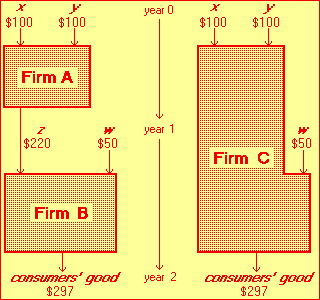For instance, Firm A's tax on its $20 profit is $20 ![]() 20% = $4.00. Notice, however, that A must pay its tax one year earlier than the other two firms. In order to account properly for this difference in time preference when comparing the firms, we shall consider their tax relative to the same reference point in time—specifically, at Year 2. At the prevailing 10% interest rate, Firm A's $4.00 tax at Year 1 equates to a $4.40 tax at Year 2. The taxes of the three firms are compared in the table on the next page.
20% = $4.00. Notice, however, that A must pay its tax one year earlier than the other two firms. In order to account properly for this difference in time preference when comparing the firms, we shall consider their tax relative to the same reference point in time—specifically, at Year 2. At the prevailing 10% interest rate, Firm A's $4.00 tax at Year 1 equates to a $4.40 tax at Year 2. The taxes of the three firms are compared in the table on the next page. ![]()
